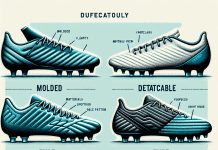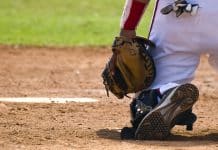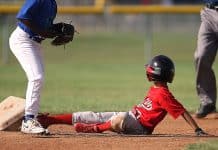Ladies and gentlemen, let’s talk about the crucial topic of finding the perfect size baseball cleats. We know how frustrating it can be when you’re out on the field, ready to play your best game, and your feet are suffering in ill-fitting footwear. Fear not, for we are here to guide you through the process of finding those comfortable, snug-fitting cleats that will enhance your performance and keep you at the top of your game. So, put on your reading cleats and let’s get started on this journey to finding the right size baseball cleats!
Understanding the Importance of the Right Size Baseball Cleats
When it comes to playing baseball, having the right equipment is crucial for success on the field. One often overlooked piece of equipment that can greatly impact your performance is your baseball cleats. Getting the right size cleats is essential for enhanced performance, prevention of injuries, and overall comfort and durability.
Review contents
Enhanced Performance on the Field
Wearing the proper size baseball cleats can greatly enhance your performance on the field. Ill-fitting cleats can hamper your ability to run, change direction quickly, and maintain balance. When your cleats fit correctly, you feel more connected to the ground, allowing for greater stability and agility. This can give you a competitive edge and help you perform at your best.
Prevention of Injuries
Choosing the right size cleats is also essential for preventing injuries. Ill-fitting cleats can lead to blisters, corns, and calluses, which can be painful and affect your performance. Additionally, wearing cleats that are too small or too tight can cause foot and toe injuries, such as sprains or fractures. On the other hand, wearing cleats that are too big or loose can increase the risk of ankle injuries. By selecting the right size cleats, you can minimize the risk of these injuries and stay on top of your game.
Comfort and Durability
Comfort is key when it comes to any type of athletic footwear, and baseball cleats are no exception. Choosing the right size cleats ensures a comfortable fit that allows for natural movement and reduces discomfort during extended periods of play. Additionally, properly fitting cleats are more likely to be durable and withstand the demands of the game. Cleats that are too small may start to tear or come apart, while cleats that are too big may lead to excessive wear and tear. By selecting the right size, you can ensure both comfort and durability for your baseball cleats.
Determining Your Correct Baseball Cleats Size
Now that we understand the importance of the right size baseball cleats, let’s explore how to determine your correct size. Here are some key factors to consider:
Measuring Your Feet
The first step in finding the right size cleats is to measure your feet. Start by standing on a piece of paper and tracing the outline of both feet with a pencil. Measure the length from the heel to the longest toe and use this measurement as a guide when consulting the size charts provided by baseball cleat manufacturers.
Considering Toe Space
When trying on baseball cleats, it’s important to consider toe space. Allow for about a half-inch of space between your longest toe and the front of the cleats. This ensures that your toes have room to move and prevents discomfort and potential injuries.
Understanding Different Widths
Aside from length, width is another important factor to consider when choosing baseball cleats. Different individuals have different foot widths, and this can impact the overall fit and comfort of the cleats. Most cleats come in standard widths, but some brands offer options for wide or narrow feet. Make sure to choose a width that accommodates the natural shape of your feet.
Accounting for Socks
When trying on baseball cleats, it’s important to wear the socks you will typically wear during games. This ensures a more accurate fit and helps you determine if the cleats will accommodate the thickness of your socks. Remember, your cleats should fit comfortably with your socks on.
Consulting the Size Charts
Each baseball cleat manufacturer provides size charts that correlate foot measurements to cleat sizes. These size charts can serve as a useful reference point when determining your correct size. Remember that sizes can vary between brands, so it’s important to consult the specific size chart for the brand of cleats you are interested in purchasing.
Trying on Multiple Sizes
Lastly, it’s always a good idea to try on multiple sizes to ensure the best fit. Feet can vary in shape and size, and what works for one person may not work for another. Trying on different sizes allows you to compare and determine which size provides the best overall fit, comfort, and performance.
This image is property of dks.scene7.com.
Factors to Consider When Choosing Baseball Cleats
When choosing baseball cleats, there are several factors to consider that go beyond just the size. These factors can greatly impact your playing experience:
Playing Position
The position you play in baseball can influence the type of cleats you should choose. Different positions require different levels of agility and support. For example, outfielders may benefit from cleats with metal studs for better traction on grass, while infielders may opt for molded cleats for quick movements on dirt.
Playing Surface
The playing surface is another important consideration when deciding on the type of cleats to wear. Baseball can be played on a variety of surfaces, including grass, dirt, and turf. Different cleat types are designed to perform optimally on different surfaces. It’s important to choose cleats that are suitable for the surface you will be playing on to ensure maximum performance and safety.
Ankle Support
Ankle injuries are common in baseball, and choosing the right cleats can help prevent them. Cleats that provide ankle support can stabilize the foot and reduce the risk of injuries. High-top cleats or cleats with added ankle straps can offer increased support and protection for players who are prone to ankle injuries or require extra stability.
Cleat Type
There are three main types of baseball cleats: molded, metal, and turf shoes. Each type has its own advantages and considerations:
Molded Baseball Cleats
Molded cleats have rubber or plastic studs attached to the outsole. They are versatile and suitable for various playing surfaces, including grass and dirt. Molded cleats provide good traction, are more comfortable, and are generally allowed in all leagues. However, they may not provide as much traction on wet or muddy surfaces as metal cleats.
Metal Baseball Cleats
Metal cleats have metal studs or spikes attached to the outsole. They offer excellent traction, especially on grass, and are favored by many professional and advanced-level players. However, metal cleats can be more abrasive on playing surfaces and are often prohibited in leagues with younger players or certain recreational leagues due to safety concerns.
Turf Shoes
Turf shoes, as the name suggests, are designed specifically for artificial turf surfaces. They have short rubber nubs on the outsole, providing excellent traction without damaging the turf. Some players may also prefer turf shoes for practice or training sessions on grass or dirt fields.
Considering the playing position, playing surface, ankle support needs, and cleat type can help ensure you select the right baseball cleats for your unique playing style and requirements.
Different Baseball Cleats Styles and Their Sizing Considerations
Apart from the different types of cleats, various styles within each type have specific sizing considerations. Let’s explore the sizing considerations for each type:
Molded Baseball Cleats
Molded cleats are available in low-top and mid-top styles. Low-top cleats offer increased mobility and flexibility, while mid-top cleats provide more ankle support. When trying on molded cleats, it’s important to ensure a snug fit that offers stability and comfort. The length and width should be suitable, with enough space for your toes to move freely.
Metal Baseball Cleats
Metal cleats come in both low-top and mid-top styles as well. When trying on metal cleats, it’s crucial to pay attention to the fit around the ankle and heel to ensure stability. The metal studs should provide solid traction and grip on the playing surface. Additionally, ensure that the length and width of the cleats are suitable for your feet.
Turf Shoes
Turf shoes are typically available in low-top styles. These shoes often have a more forgiving fit compared to cleats, but it’s still important to ensure a comfortable fit that offers stability. Turf shoes should provide adequate traction on artificial turf surfaces while allowing for natural movement.
This image is property of images.contentstack.io.
Tips for Getting the Right Fit in Baseball Cleats
Finding the right fit in baseball cleats can take some trial and error. Here are some tips to help guide you in your search:
Try Different Brands and Models
Different brands and models may vary in terms of fit and sizing. It’s worth trying on cleats from multiple brands and models to find the one that fits you best. You may find that certain brands or models cater better to the shape and size of your feet.
Consider the Break-In Period
Baseball cleats, especially those made of leather, often require a break-in period. This means that they may feel slightly tight or uncomfortable initially but will gradually mold to the shape of your feet over time. Take this into consideration when trying on cleats, and allow for some adjustment and flexibility in your sizing decision.
Consult with Other Baseball Players
If you have teammates or friends who play baseball, it’s always helpful to seek their advice and input. They may have personal experiences or insights regarding cleat sizing and can offer valuable recommendations. Don’t hesitate to ask for their opinions on different brands, sizing, or specific models they have found to be comfortable and reliable.
Visit a Local Store
While online shopping offers convenience, visiting a local store can provide the opportunity to try on different cleats in person. This allows for a more accurate assessment of fit and comfort. Additionally, store staff may be able to provide guidance and recommendations based on their knowledge and expertise.
Common Mistakes to Avoid When Choosing Baseball Cleats
When choosing baseball cleats, it’s important to avoid common mistakes that can lead to an improper fit and unsatisfactory performance. Here are some mistakes to watch out for:
Buying Oversized Cleats
Buying cleats that are too big in the hopes of growing into them is a common mistake. Oversized cleats can cause discomfort, instability, and potential foot injuries. It’s important to choose cleats that fit properly from the start to ensure optimal performance and protection.
Purchasing Without Trying Them On
While online shopping offers convenience, it’s generally not recommended to purchase baseball cleats without trying them on first. The fit and comfort of cleats can vary significantly between brands and models, and what works for one person may not work for another. Trying them on allows you to assess the fit, comfort, and overall feel before making a purchase.
Neglecting Important Features
When selecting baseball cleats, it’s important to consider important features beyond just the size and fit. Look for cleats that offer appropriate traction, ankle support, and durability. Neglecting these features can compromise your performance and increase the risk of injuries.
Ignoring Arch Support
Arch support is crucial for maintaining proper foot alignment and reducing the risk of foot and leg discomfort. If you have high or low arches, it’s important to choose cleats that provide adequate arch support. Neglecting this aspect can lead to discomfort and potential foot problems over time.
Being Influenced by Branding
While brand reputation may carry some weight, it’s important not to be solely influenced by branding when choosing baseball cleats. Different brands can vary in terms of fit, comfort, and performance. Focus on finding the right size and fit, considering important features, and choosing cleats that cater to your specific playing needs and preferences.
This image is property of cdn.baseballexpress.com.
Maintenance and Care for Baseball Cleats
Proper maintenance and care for your baseball cleats can extend their lifespan, ensuring continued performance and comfort. Here are some tips:
Cleaning and Drying
After each use, it’s important to clean your cleats to remove dirt, mud, or grass stains. Use a soft brush or cloth to gently scrub the surface of the cleats, and remove any debris from the studs. Allow them to air dry naturally, away from direct heat sources, which can cause damage or deformation.
Storage
When not in use, store your cleats in a cool and dry place, away from direct sunlight. Wipe them clean and ensure they are fully dry before placing them in a storage bag or box. Proper storage can help maintain the shape and integrity of the cleats.
Replacing Worn Cleats
Over time, cleats can become worn or damaged, compromising their performance and safety. It’s important to regularly inspect your cleats for signs of wear and tear, such as worn outsole material, loose threads, or damaged studs. If significant damage or wear is present, it may be time to replace your cleats to ensure you continue to perform at your best.
Conclusion
Choosing the right size baseball cleats is crucial for optimizing your performance, preventing injuries, and ensuring overall comfort and durability. By measuring your feet, considering toe space, understanding different widths, accounting for socks, consulting size charts, and trying on multiple sizes, you can determine your correct size. When selecting baseball cleats, factors such as playing position, playing surface, ankle support needs, and cleat type should be considered. Avoid common mistakes such as buying oversized cleats, purchasing without trying them on, neglecting important features, ignoring arch support, and being solely influenced by branding. Proper maintenance and care, including cleaning, drying, appropriate storage, and replacing worn cleats, can help prolong the lifespan and performance of your baseball cleats. By taking the time to find the right size and fit, you can enhance your performance, stay comfortable, and enjoy the game to the fullest.
This image is property of www.big5sportinggoods.com.









































